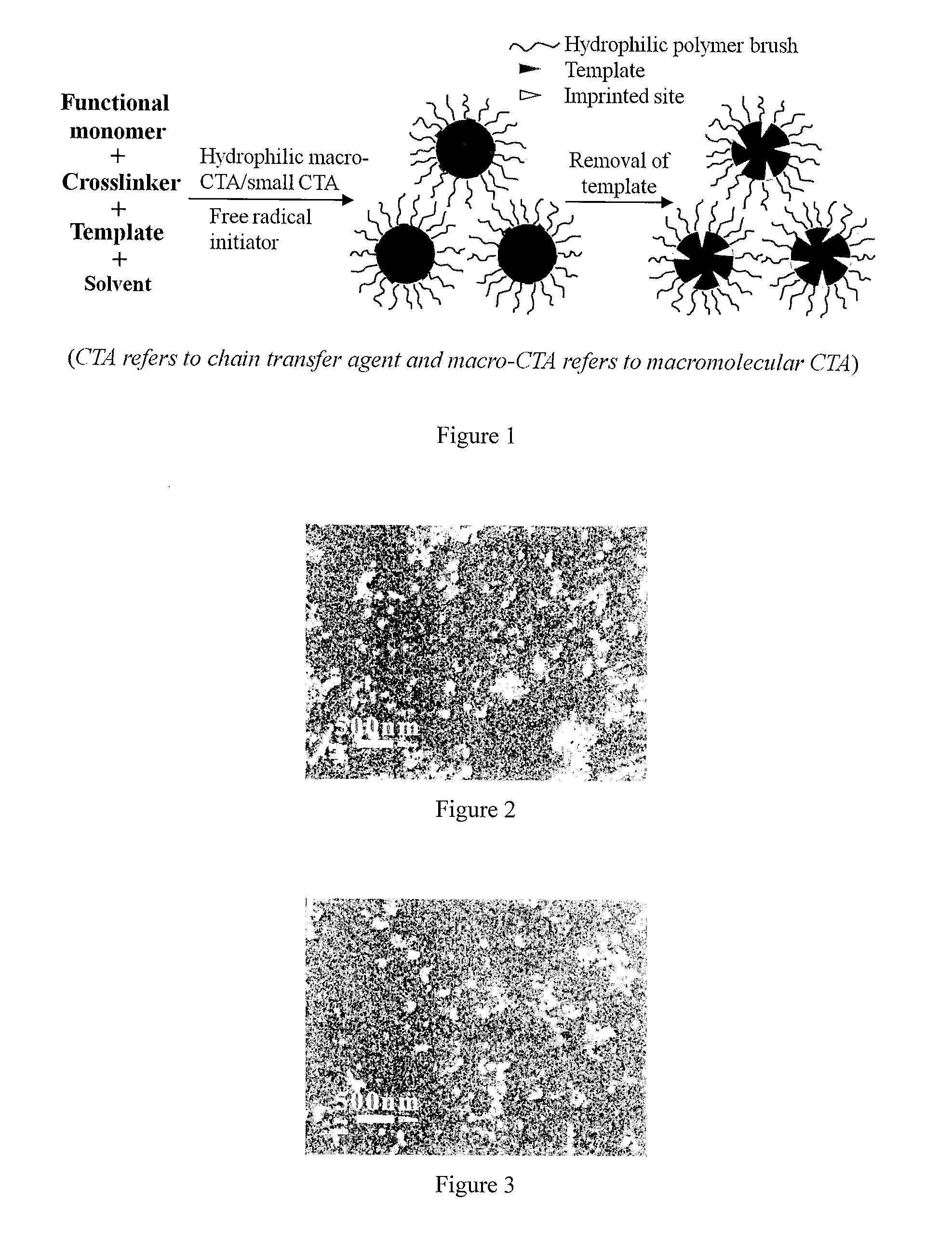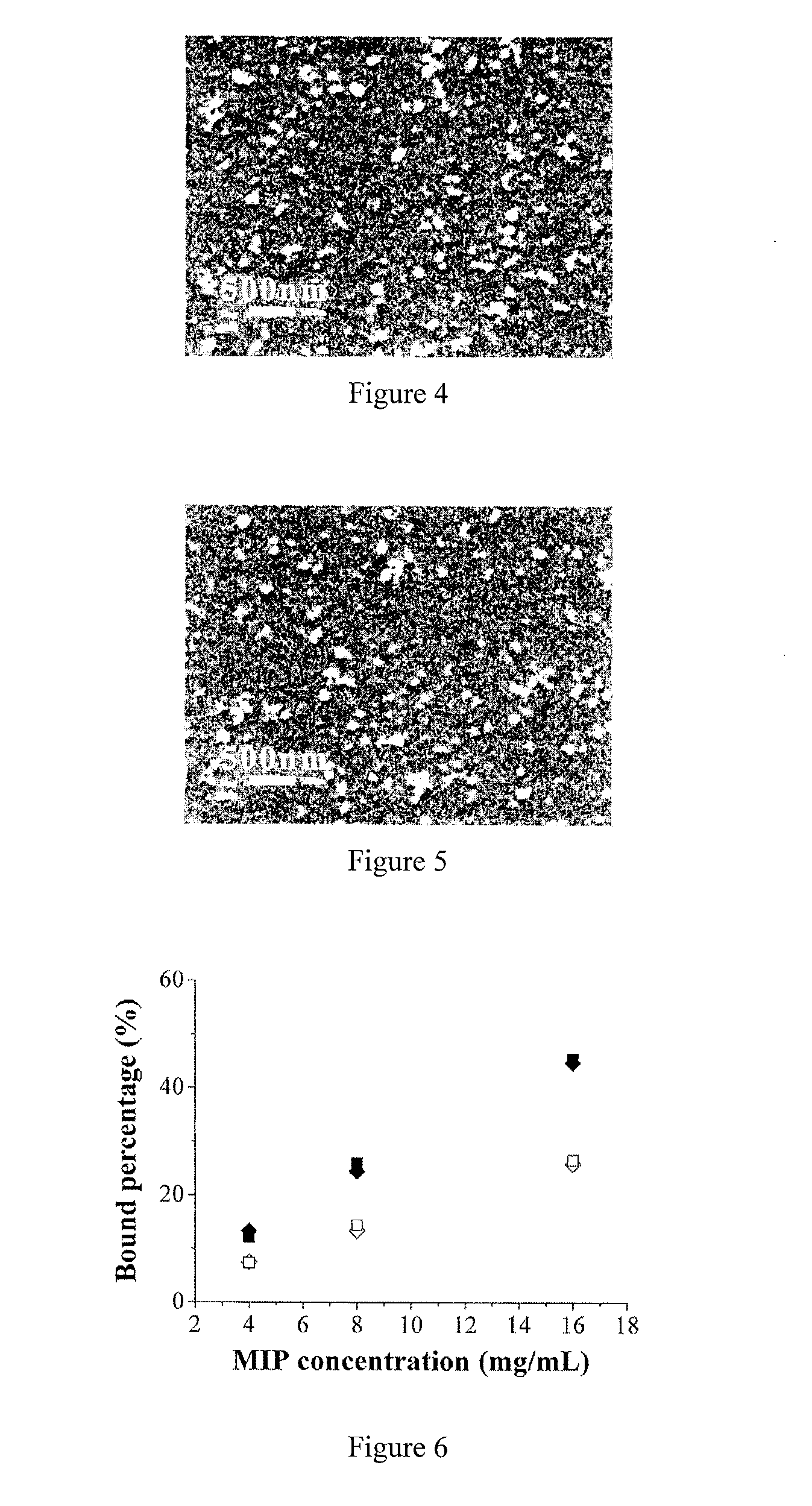Molecularly imprinted polymer nanoparticles compatible with biological samples and preparation method thereof
a technology of imprinting and nanoparticles, applied in the field of molecular imprinting polymer nanoparticles, can solve the problems of limiting the broad application range of the material, limiting the broad practical application range, and being unable to meet the requirements of biological samples, etc., and achieving the rarest possible compatibility with aqueous samples
- Summary
- Abstract
- Description
- Claims
- Application Information
AI Technical Summary
Benefits of technology
Problems solved by technology
Method used
Image
Examples
examples
[0074]The following examples are only used to illustrate the embodiments of the present invention, and they should not be interpreted as the limitation of the invention in any way.
preparation examples
Example 1
[0075]2,4-D (0.83 mmol) is added into a one-neck round-bottom flask (100 mL) containing a mixture of methanol and water (4:1 v / v, 60 mL), and a clear solution is obtained after magnetic stirring, and then 4-vinylpyridine (0.83 mmol) is added into the above solution. After their thorough mixing for 0.5 h, ethylene glycol dimethacrylate (2.50 mmol), small chain transfer agent cumyl dithiobenzoate (CDB) (0.055 mmol), poly(2-hydroxyethyl methacrylate) macromolecular chain transfer agent (Mn,NMR=4800) (0.034 mmol), and azobisisobutyronitrile (AIBN) (0.028 mmol) are added successively. After being purged with argon for 30 min, the reaction mixture is sealed and immersed into a thermostatted oil bath at 60° C. The polymerization is allowed to take place for 10 h. The resulting polymer particles are collected by high speed centrifugation.
[0076]The above product is purified by being washed with methanol / acetic acid (9:1 v / v) and methanol until no template is detectable in the centri...
example 2
[0078]2,4-D (0.83 mmol) is added into a one-neck round-bottom flask (100 mL) containing a mixture of methanol and water (4:1 v / v, 60 mL), and a clear solution is obtained after magnetic stirring, and then 4-vinylpyridine (0.83 mmol) is added into the above solution. After their thorough mixing for 0.5 h, ethylene glycol dimethacrylate (2.50 mmol), small chain transfer agent cumyl dithiobenzoate (CDB) (0.055 mmol), poly(2-hydroxyethyl methacrylate) macromolecular chain transfer agent (Mn,NMR=3250) (0.034 mmol), and azobisisobutyronitrile (AIBN) (0.028 mmol) are added successively. After being purged with argon for 30 min, the reaction mixture is sealed and immersed into a thermostatted oil bath at 60° C. The polymerization is allowed to take place for 10 h. The resulting polymer particles are collected by high speed centrifugation.
[0079]The above product is purified by being washed with methanol / acetic acid (9:1 v / v) and methanol until no template is detectable in the centrifugated s...
PUM
| Property | Measurement | Unit |
|---|---|---|
| Fraction | aaaaa | aaaaa |
| Fraction | aaaaa | aaaaa |
| Fraction | aaaaa | aaaaa |
Abstract
Description
Claims
Application Information
 Login to View More
Login to View More - R&D
- Intellectual Property
- Life Sciences
- Materials
- Tech Scout
- Unparalleled Data Quality
- Higher Quality Content
- 60% Fewer Hallucinations
Browse by: Latest US Patents, China's latest patents, Technical Efficacy Thesaurus, Application Domain, Technology Topic, Popular Technical Reports.
© 2025 PatSnap. All rights reserved.Legal|Privacy policy|Modern Slavery Act Transparency Statement|Sitemap|About US| Contact US: help@patsnap.com



